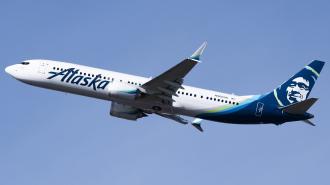The aviation industry is still in shock from a near disaster on Jan. 5, 2024, in which a 60-pound “door plug” blew out from a nearly new Boeing 737 MAX 9 in flight at 16,000 feet, leaving a gaping hole in the fuselage.
In response, the Federal Aviation Administration grounded all 737 MAX 9 planes with such plugs, and aviation authorities in other countries have followed suit.
The industry is watching closely.
A lot of news coverage has emphasized the impressive safety record of the global airline industry, particularly since an Alaska Airlines crew managed to land the plane with no fatalities. I commend the outstanding performance of airline employees, air traffic controllers and emergency responders who achieved this impressive feat.
However, as a former United Airlines pilot now lecturing in Yale University’s School of Management, I believe the wrong questions are being asked about what happened on Alaska Airlines Flight 1282. As the National Transportation Safety Board and numerous news outlets have explained, door plugs are commonly used to seal unused exits on commercial airliners. The question we need to ask is: Why wouldn’t an airline use all of an aircraft’s emergency exits? Wouldn’t that make passengers safer?
It’s all about money.
Safety isn’t free
Airlines have lots of expenses. Some, such as jet fuel, are easier to calculate. Others, such as emergency exits, are more opaque to travelers.
Believe it or not, every functioning emergency exit comes at a price for an airline. Each requires routine maintenance and frequent inspections – for example, to make sure that emergency evacuation slides work properly – and flight attendants must staff emergency exits during takeoff and landing for safety reasons.
In other words, every working exit comes with associated costs in salaries, health benefits, pension plans, training and related expenses. Sealing off an emergency exit cuts costs.
But is every one of those emergency exits crucial? From the U.S. government’s perspective, not necessarily.
Why you get more emergency exits in Indonesia
In the U.S., airlines must comply with federal aviation regulations, which dictate aircraft maintenance procedures and in-flight personnel assignments – and minimum standards for emergency exits.
The issue is that Boeing sells the same airplane to different airlines with different needs.
Boeing notes that its 737 MAX 9 can carry up to 220 passengers, which, under U.S. regulations, requires it be built with a specific number of emergency exits. This dense seating configuration is common among lower-cost global airlines such as Jakarta-based Lion Air.
However, given Americans’ desire for legroom, most U.S. carriers are equipped with considerably fewer than 220 seats – and when there are fewer than 190 seats, the rules allow fewer emergency exits to be in service. The Alaska Airlines Max 9 had just 178 seats.
Under these conditions, the federal rules allow air carriers to disable these exits and plug the openings. That’s precisely what happened with Alaska Airlines Flight 1282 – and how “door plug” suddenly entered the American vernacular.
Although this sort of workaround is authorized, it’s unclear to me that this is in the best interest of air safety. Wouldn’t it be better for the FAA to require that all exits are available for use in an emergency, regardless of aircraft seating capacity, even if it required some additional expense for airlines?
A worrying safety record
The 737 MAX is a plane of many firsts – not all of them positive.
The MAX is the latest addition to Boeing’s 737 family of aircraft. The 737 family has far eclipsed all rivals as the most popular commercial airliner ever built, with over 10,000 sold worldwide since its introduction in 1967.
Some carriers, such as Southwest Airlines in the United States and Ryanair in Ireland, fly only 737s; it’s a critical element of their low-cost business strategy. By flying just one type of aircraft, these airlines significantly improve scheduling flexibility while cutting maintenance and training costs.
That’s all to say that demand for the latest 737 was high. In 2017, when the FAA certified the 737 MAX safe for flight, Boeing had already received more than 3,600 new orders from 83 customers.
But very shortly afterward, two crashes that together killed 346 people grounded the 737 MAX for nearly two years – another first as the longest airline grounding in aviation history. Destined to profit US$12 million on the sale of each $121 million MAX, there was significant incentive for Boeing to press on with MAX development even though it had already proved to be a dangerously problematic aircraft design.
In 2020, the FAA recertified the MAX as “safe for flight”; by 2023, Boeing had logged more than 7,000 total orders for the MAX, far eclipsing the sale of any other type of airliner. This fact alone ought to raise safety concerns. It may soon prove impossible to avoid flying on a 737 MAX, particularly in the U.S. domestic market. United, American, Southwest and Alaska airlines all currently fly the MAX.
When airplane parts and passengers’ cellphones are raining from the sky, it could be a sign that the industry needs to think harder about unintended costs – and consequences.
This article is republished from The Conversation under a Creative Commons license. Read the original article.






